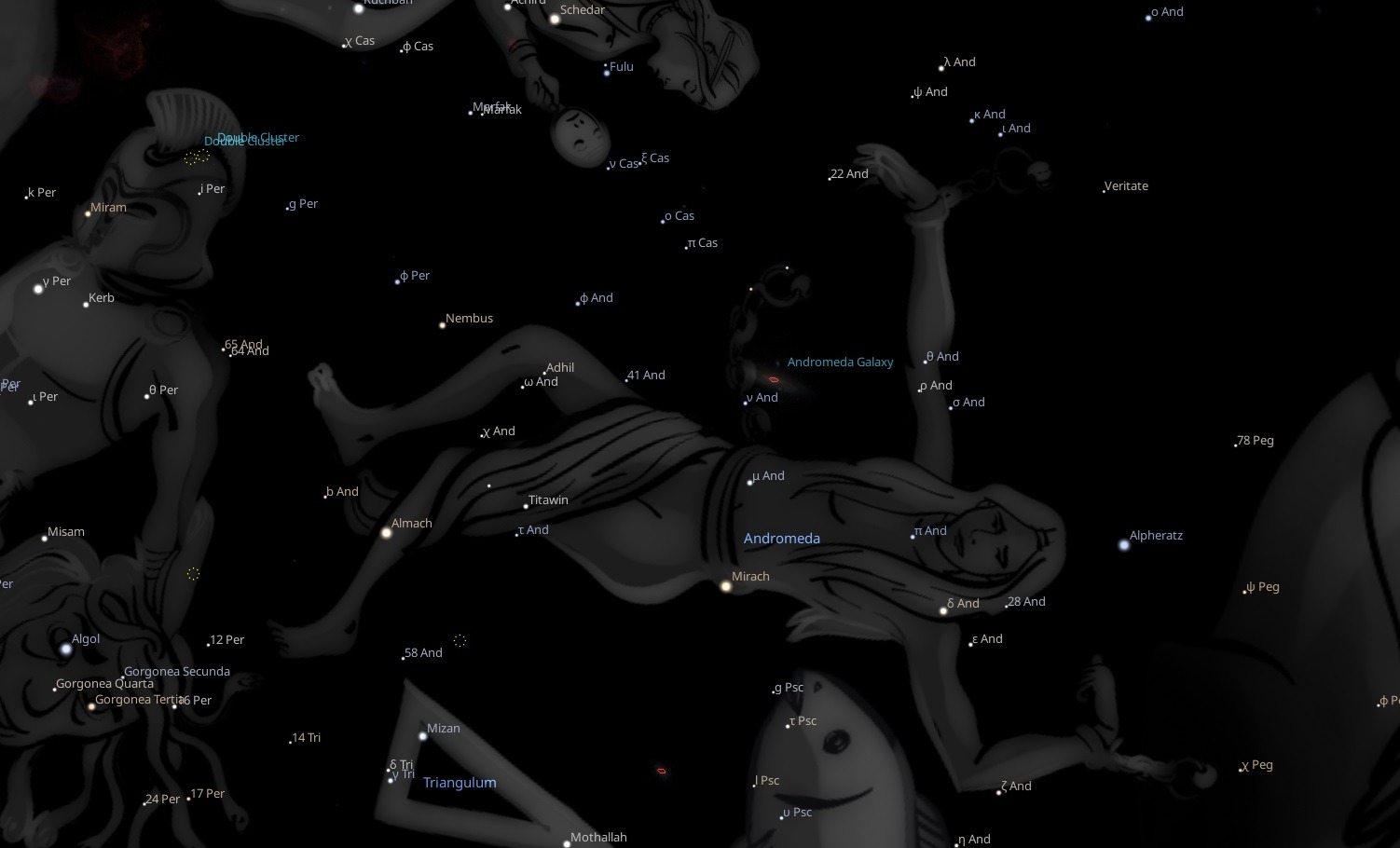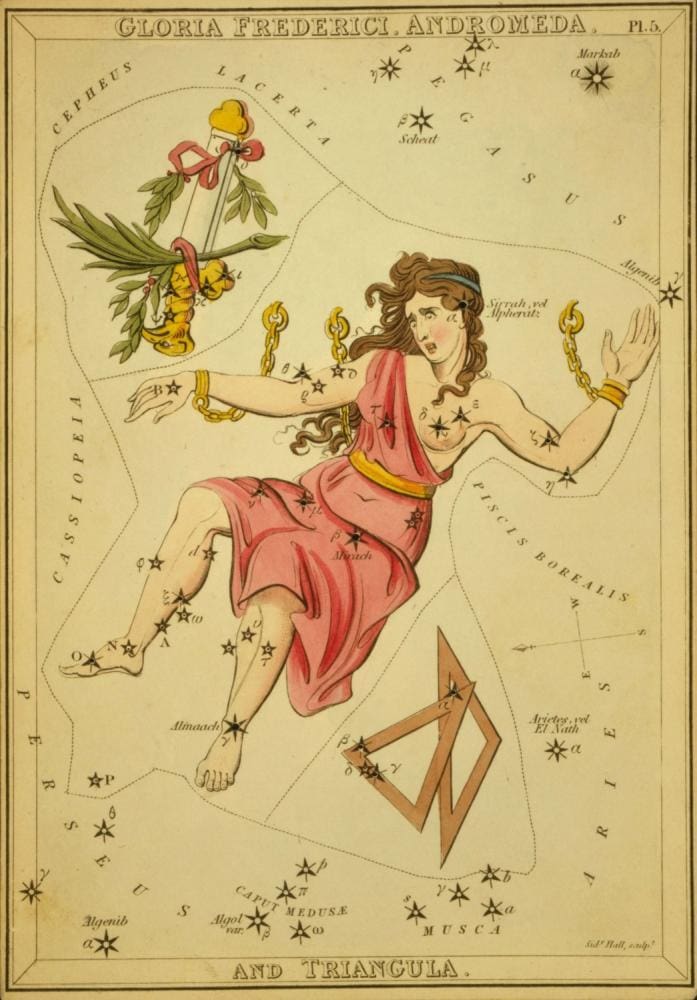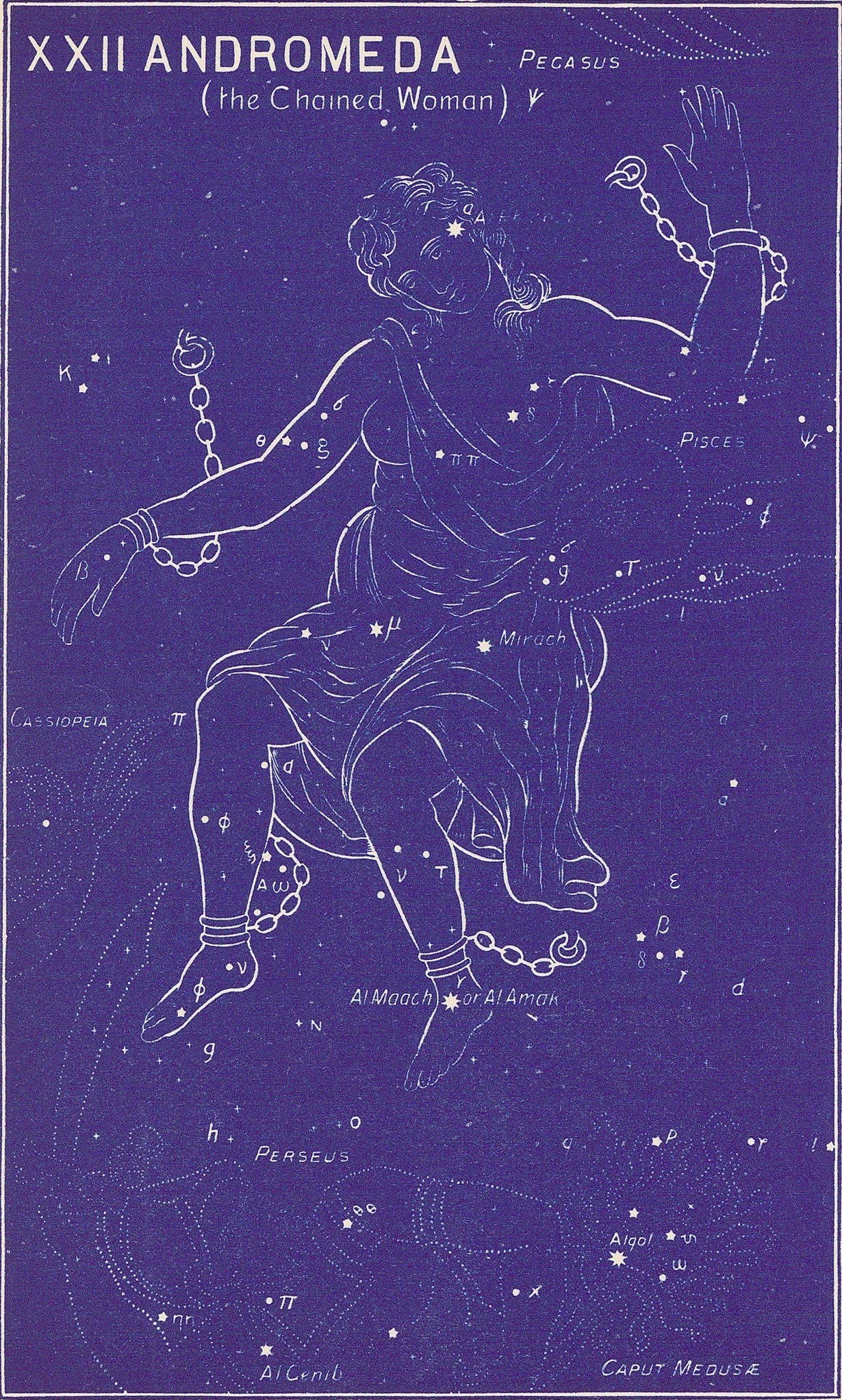FIXED STARS: Major Stars | 1000+ Stars | Constellations | About
Constellation Andromeda the Chained Woman is a northern constellation bordering Perseus, Cassiopeia, Lacerta, Pegasus, Pisces, Triangulum and the obsolete constellation Frederici Honores.Andromeda is one of the 48 constellations listed by Ptolemy in the 2nd century and remains one of the 88 modern constellations. It spans 45 degrees of the zodiac in the Signs of Aries and Taurus.
Abbreviation: And
Genitive: Andromedae
Andromeda Constellation Stars
| 2000 | 2050 | Star | Name | Sp. Class | Mag. | Orb |
|---|---|---|---|---|---|---|
| 07♈47 | 08♈29 | ο And | B6 | 3.62 | 1°40′ | |
| 11♈58 | 12♈40 | 14 And | Vertitate | K0 | 5.22 | 1°00′ |
| 14♈19 | 15♈01 | α And | Alpheratz | B8 | 2.07 | 2°10′ |
| 14♈39 | 15♈21 | 3 And | K0 | 4.64 | 1°00′ | |
| 15♈44 | 16♈26 | 7 And | F0 | 4.53 | 1°10′ | |
| 16♈05 | 16♈47 | ι And | Rasalnaqa | B8 | 4.29 | 1°20′ |
| 16♈25 | 17♈07 | 8 And | M2 | 4.82 | 1°00′ | |
| 17♈18 | 17♈50 | κ And | Kaffalmusalsal | B9 | 4.15 | 1°20′ |
| 18♈17 | 18♈59 | λ And | G8 | 3.81 | 1°30′ | |
| 19♈56 | 20♈38 | ψ And | G5 | 4.97 | 1°00′ | |
| 20♈35 | 21♈17 | ζ And | Tiānshǐmù | K1 | 4.08 | 1°20′ |
| 21♈49 | 22♈31 | δ And | Sadiradra | K3 | 3.27 | 1°50′ |
| 27♈51 | 28♈33 | M31 | Vertex | 3.44 | 1°40′ | |
| 29♈11 | 29♈53 | μ And | A5 | 3.86 | 1°30′ | |
| 00♉25 | 01♉07 | β And | Mirach | M0 | 2.07 | 2°10′ |
| 06♉25 | 07♉07 | φ And | Jūnnánmén | B7 | 4.26 | 1°20′ |
| 07♉52 | 08♉34 | ξ And | Adhil | K0 | 4.87 | 1°00′ |
| 08♉33 | 09♉15 | υ And | Titawin | F8 | 4.10 | 1°20′ |
| 12♉27 | 13♉09 | 51 And | Nembus | K3 | 3.59 | 1°40′ |
| 14♉14 | 14♉56 | γ And | Almach | K3 | 2.10 | 2°10′ |
| 21♉49 | 22♉31 | 65 And | K4 | 4.73 | 1°00′ |
δ And is named Sadiradra, derived from the Arabic al-sadr al-adhra’a (الصدر العذراء), “the bosom of the maiden.” [1]
ζ And has the Chinese names Tiānshǐmù (天豕目), “Celestial pig’s eye,” and Dàjiāng (大将), “Great general.” [2]
ι And is officially named Rasalnaqa, from the Arabic Ra’s al-Nāqa, “the head of the she-camel.” (Initially, the three stars ι And, κ And, and λ And were known as Keff al-Salsalat (كف المسلسلة – kaf al-musalsala), “hand of the chained woman,” and in traditional Arabic astronomy as Ra’s al-Nāqa, “the head of the she-camel.”) [3]
κ And is officially named Kaffalmusalsal, from the Arabic kaf al-musalsala (كف المسلسلة -), “hand of the chained woman.” [3]
ξ And is officially named Adhil, derived from the Arabic Al Dhail, “the Train of a Garment.” [4]
υ And is officially named Titawin, from the Berber name Tiṭṭawin (ⵜⵉⵟⵟⴰⵡⵉⵏ), of Morocco’s Tétouan city and Tunisia’s Tataouine city. [5]
υ And is also named Adhab, from the Arabic عذاب, “punishment” or “submission”. [13]
φ And has the traditional Chinese name Jūnnánmén (軍南門), “Southern Military Gate.” [2]
χ And has the traditional Chinese name Tiāndàjiāngjūnwu (天大將軍五), “5th star of Heaven’s Great General”. [2]
χ And is erroneously named Keun Nan Mun because Allen said φ and χ were Keun Nan Mun, the “Camp’s South Gate.” [4]
14 And is officially named Vertitate, Latin for “truth.”
51 And is officially named Nembus, of unknown meaning.
51 And is also named Al Anfal, “the spoils of war,” [1] from the Arabic word anfal (انفال) “Spoils” or “Plunder”, or from the Arabic asterism al-saif wa al-anfal (السيف و الانفال), “The Sword and the Spoils”. [12]
Andromeda Astrology
Manilius
The man whose birth coincides with the rising of Andromeda from the sea will prove merciless, a dispenser of punishment, a warder of dungeon dire; he will stand arrogantly by while the mothers of wretched prisoners lie prostrate on his threshold, and the fathers wait all night to catch the last kisses of their sons and receive into their inmost being the dying breath. From the same constellation comes the figure of the executioner, ready to take money for a speedy death and the rites of a funeral pyre, for him execution means profit, and oft will he bare his axe; in short, he is a man who could have looked unmoved on Andromeda herself fettered to the rock. Governor of the imprisoned he occasionally becomes a fellow convict, chained to criminals so as to save them for execution. [6]
Maternus
Andromeda arises in the 12th degree of Pisces [336 AD]. Whoever was born with this constellation rising will always attack men with a cruel savagery. Moreover, he will be either the deliverer of public punishments, or a prison guard, or an executioner of whom the duty of killing men is entrusted.
But if a benefit star [planet] joined with a malefic one aspects this place, it makes those in charge of convicts or metals. But if this constellation is found in the DSC, and the malefic stars aspected that place, it will make [those] thrown to wild beasts or those hung on a cross. But if the favor of the benefit stars approaches the malefics arranged thus, they will make these persons to be assigned to the [gladiatorial] games, or to be perpetually bound in bonds of chains. [7]
Robson
ANDROMEDA. The Chained Woman.
Legend. Andromeda was the daughter of Cepheus, king of Æthiopeia, and Cassiopeia. In consequence of Cassiopeia’s boast that the beauty of Andromeda surpassed that of the Nereids, Neptune sent a sea monster (CETUS) to lay waste to the country, and promised deliverance only on condition that Andromeda were offered as a sacrifice to it. She was accordingly chained to a rock, but was discovered and released by Perseus, who, riding through the air on Pegasus, slew the monster by turning it to stone with the Medusa’s Head and claimed Andromeda as his bride.
Influence. According to Ptolemy the influence of this constellation is similar to that of Venus, though the legend would lead one to suppose some connection with Virgo. It is said to bestow purity of thought, virtue, honor and dignity upon its natives, but to cause battle with chimerical fears and a tendency to become easily discouraged. By the Kabalists it is associated with the Hebrew letter Pé and the 17th Tarot Trump, The Stars. If Mars afflicts the luminaries from Andromeda, and especially if in an angle, it causes death by hanging, decapitation, crucifixion or impalement.
Magical. Gives love between husband and wife and reconsiles adulterers. [8]
Noonan
Tetrabiblos asserts that the brights stars of this constellation are of the nature of Venus and so os its brightest star. It is a generally favorable constellation denoting that which is honorable and eminent. Badly placed, however, it can portend earthquakes, and in the Middle Ages was said that Mars in this constellation in aspect with the Sun caused death by crucifixion or hanging. [9]
Allen
Andromeda, the Woman Chained… represents in the sky the daughter of Cepheus and Cassiopeia, king and queen of Aethiopia, chained in exposure to the sea monster as punishment of her mother’s boast of beauty superior to that of the Nereids.
but she seems to go far back of classical times, and we probably must look to the Euphrates for her origin, with that of her family and Cetus. Sayce claims that she appeared in the great Babylonian Epic of Creation, of more than two millenniums before our era, in connection with the story of Bēl Mardūk and the dragon Tiamat that doubtless is the foundation of the story of Perseus and Andromeda. She was noted, too, in Phoenicia, where Chaldaean influence was early felt.
As a constellation these stars have always borne our title, frequently with the added Mulier Catenata, the Woman Chained, and many of the classical Latins alluded to her as familiar and a great favorite. Caesar Germanicus called her Virgo Devota; a scholiast, Persea, as the bride of Perseus; while Manilius, and Germanicus again, had Cepheis, from her father.
Andromeda is bounded on the north by Cassiopeia and Perseus; on the east by Perseus; on the south by Pisces and Triangulum; and on the west by Lacerta and Pegasus.
The stars that mark her right arm may be seen stretching from σ to ι and κ; ζ marking the left arm with the end of the chain towards Lacerta; but in early days she was somewhat differently located, and even till recently there has been confusion here; for Smyth wrote:
Flamsteed’s Nos. 51 and 54 Andromedae are ψ and υ Persei, though placed exactly where Ptolemy wished them to be — on the lady’s foot: so also α in this asterism has been lettered δ Pegasi by Bayer, and β has been the lucida of the Northern Fish.
Argelander has 83 stars here, and Heis 138.
La Lande and Dupuis asserted that the Phoenician sphere had a broad Threshing-floor in this spot, with stars of Cassiopeia as one of the Gleaners in the large Wheat-field that occupied so much of that people’s sky; its exact boundaries, however, being unknown to us. [4]
Bullinger
This is a peculiar picture to set in the heavens. A woman with chains fastened to her feet and arms, in misery and trouble; and bound, helpless, to the sky. Yet this is the ancient foreshowing of the truth. In the Denderah Zodiac, her name is Set, which means set, set up as a queen. In Hebrew it is Sirra, the chained, and Persea, the stretched out.
There are 63 stars in this constellation, three of which are of the 2nd magnitude, two of the 3rd, twelve of the 4th, etc. The brightest star, a (in the head), is called Al Phiratz (Arabic), the broken down. The star b (in the body) is called Mirach (Hebrew), the weak. The star g (in the left foot) is called Al Maach, or Al Amak (Arabic), struck down. The names of other stars are Adhil, the afflicted; Mizar, the weak; Al Mara (Arabic), the afflicted. [10]
References
- Delta Andromedae – Wikipedia
- Andromeda in Chinese astronomy
- Iota Andromedae – Wikipedia
- Star Names: Their Lore and Meaning, Richard H. Allen, 1889, p.31-40.
- Upsilon Andromedae – Wikipedia
- Astronomica, Manilius, Book 5, 1st century A.D., p.351.
- Mathesis, Julius Firmicus Maternus, 336 AD, viii.17.1.
- Fixed Stars and Constellations in Astrology, Vivian E. Robson, 1923, p.26-27, 231.
- Fixed Stars and Judicial Astrology, George Noonan,1990. p.30.
- The Witness of the Stars, E. W. Bullinger, 1896, Andromeda (the Chained Woman).
- Constellations: Andromeda ‘the Chained Maiden’, h2g2.com
- Talk:List of stars in Andromeda – Wikipedia
- Upsilon Andromedae (Indonesian) – Wikipedia


